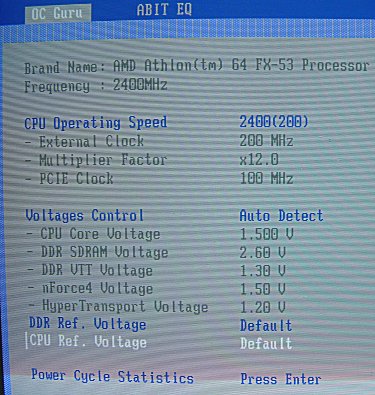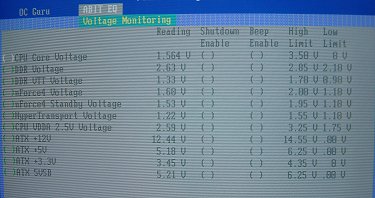BIOS
The Fatal1ty AN8 is aimed at, primarily, the enthusiast who needs the last bit of user control over BIOS and performance-related options. A strong BIOS is an absolute must, in view of the price premium this Fatality edition attracts over other reasonably featured boards.
Seems like another generic AwardBIOS offering at first glance. The first indication that it's geared towards the enthusiast is the specification of a BIOS-saving feature, whereby one can save and restore a particular configuration at the touch of a few buttons. The Fatal1ty AN8's BIOS, upgraded to iteration 13, allows one to save and restore 5 BIOS configs. ABIT, as you will see lower down, offers a mind-boggling array of voltage and fan control, so having some method of restoring a config., in case you need to clear the CMOS, is a must.
The majority of the tweaking fun is hidden behind the µGuru subscreen, so let's head on over.

I wonder why ABIT didn't go with the blue background that's easier on the eye. Rather than list the variable settings for each parameter, a handy table will make more sense.
| External clock | 200-410MHz in 1MHz increments |
| Multiplier factor | 4x - 25x in 0.5x increments, needs an unlocked S939 CPU, though |
| PCI-Express clock | 100-145MHz in 1MHz increments (lockable to any setting) |
| CPU Voltage | 1.5v-1.85v in 0.025v increments, for an FX-53 |
| DDR voltage | 2.50v-2.80v in 0.05v increments |
| DDR VTT voltage | 1.25v-1.40v in 0.05v increments |
| nForce4 voltage | 1.50v-1.80v in 0.05v increments |
| HyperTransport voltage | 1.20-1.35v in 0.05v increments |
| DDR reference voltage | +/- 100mV |
| CPU reference voltage | +/- 100mV |
A couple of things to point out here. There's obviously tremendous scope for voltage adjustment on all the crucial performance-related lines, but ABIT's CPU/DDR reference voltage changes have zero effect on reported voltages. In view of this, it would have been preferable for ABIT to offer greater levels of DDR voltage adjustment, to, say, 3.20v. All voltages lines are strong, that is, over-volt a touch, so it's a shame that one cannot choose a lower-than-default CPU voltage. Venice and San Diego Athlon 64s can get away with running on a little less juice than normal, offering the opportunity of near-silent running.

Voltage manipulation is excellent, but even that's outshone by the µGuru's fan- and voltage-reporting facility.

Clickety-click for a bigger picture. You can manually define beep and shutdown temperatures for CPU, system, and power.

A voltage geek's delight. More lines than a drug dealer!

Beeps and shutdown for any one of 6 monitored fans.

The various fans' speed can be controlled using voltages and the reference temperature that's closest to the fan(s) in question. Want them all the run quiet? Simply reduce the voltage to 6-8v. Want to overclock like no tomorrow? Set them all to 12v. The same goes for the board's OTES and auxillary fans. Also it's worth noting that fan speeds rise as temperatures begin to soar.

HyperTransport frequency is best left a 5x when running at default speeds. Be sure to reduce it to 3x when overclocking.

Auto settings worked best with a set of Corsair XMS3200XL sticks. You can. however, tweak to your heart's content. You can also appreciate just why it's so important to be able to save a particular config.
ABIT's µGuru has been designed with the enthusiast squarely in mind. It's comprehensive and useful. I'd urge ABIT to release a newer BIOS with DDR voltage topping out at a minimum 3.2v, especially in view of the board's supplied RAMFlow cooling apparatus.









